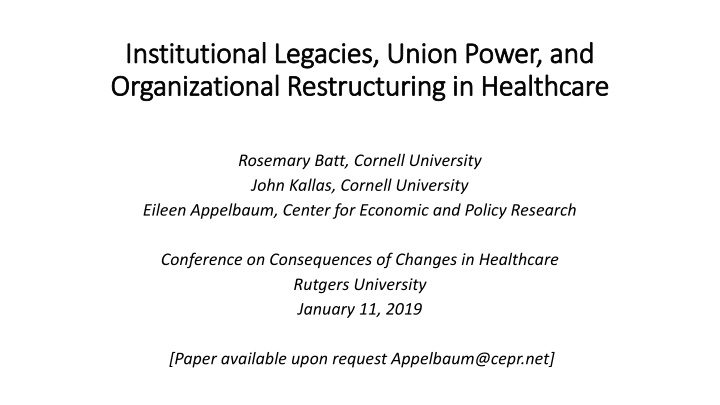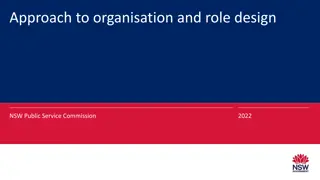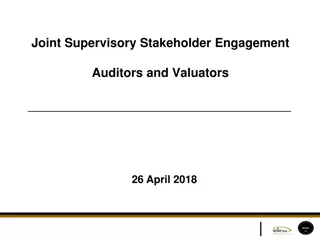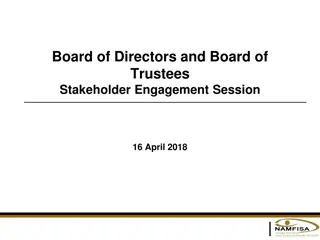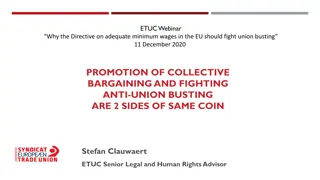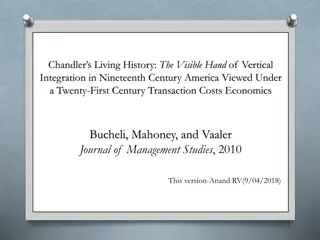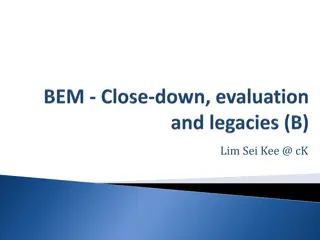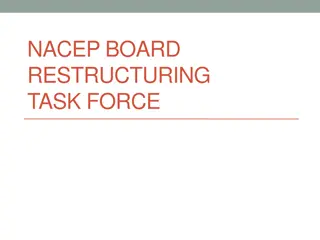Examining Union Power and Institutional Legacies in Healthcare Organizational Restructuring
Challenges faced by healthcare unions due to institutional legacies and shifts in the healthcare system are explored. The study delves into the variation in union success, emphasizing local institutional contexts in the U.S. and power dynamics between employers and unions rooted in historical continuity.
Download Presentation

Please find below an Image/Link to download the presentation.
The content on the website is provided AS IS for your information and personal use only. It may not be sold, licensed, or shared on other websites without obtaining consent from the author.If you encounter any issues during the download, it is possible that the publisher has removed the file from their server.
You are allowed to download the files provided on this website for personal or commercial use, subject to the condition that they are used lawfully. All files are the property of their respective owners.
The content on the website is provided AS IS for your information and personal use only. It may not be sold, licensed, or shared on other websites without obtaining consent from the author.
E N D
Presentation Transcript
Institutional Legacies, Union Power, and Institutional Legacies, Union Power, and Organizational Restructuring in Healthcare Organizational Restructuring in Healthcare Rosemary Batt, Cornell University John Kallas, Cornell University Eileen Appelbaum, Center for Economic and Policy Research Conference on Consequences of Changes in Healthcare Rutgers University January 11, 2019 [Paper available upon request Appelbaum@cepr.net]
Roadmap to Presentation Challenges facing healthcare unions Research question Contributions of the research Research methods and findings Implications and discussion
Background: Challenges facing Unions in Healthcare As a result of financial and regulatory change, healthcare systems are shifting services out of hospitals and into outpatient care Jobs are still growing in hospitals, but at a much higher rate in ambulatory facilities over the past decade Unionization in hospitals at 13.5% in 2015, higher than approximately 7% at both national average and unionization in outpatient facilities Clear obstacle for unions, as employers set up legally separate outpatient entities that remain part of the healthcare system but are no longer bound by the union contract Variation in union success in extending and maintaining coverage beyond traditional bargaining units
Research Question As healthcare organizations restructure, unions face difficult obstacles to organizing and representing workers What explains the variation in union success?
Our Contribution Local institutional variation Thin institutional context of the U.S. Recent literature focuses on institutional change; we find that historical continuity, path dependence are important determinants of outcomes In thin institutional environments where agency and entrepreneurship are supposed to overcome institutional constraints, we show that current outcomes for workers are rooted in power relations between employers and unions that have deep local institutional roots
Theoretical Foundation and Contribution Build on social constructionist school and power resources theory Korpi (2006): employers act as antagonist, consenters, or protagonists E.G. virulent anti-unionism (antagonist), GM in postwar accord (consenter), Saturn s response to intense global competition with labor- management cooperation (protagonist) Theorize three strategies by both unions and employers to expand their power resources: economic, ideological, and political Importance of ideological most of comparative employment relations looks at the economic power of both employers and workers need to understand how unitarist and ideational strategies impact class conflict
Case Selection Unit of analysis is unions and healthcare employers in Rochester and Buffalo, NY Two cities with many of the same characteristics Same state, state-level/national regulatory framework, < 75 miles apart, top 25 in poverty rates, deindustrialization & deunionization Major healthcare unions (1199 SEIU in both Rochester and Buffalo, CWA 1168 and CWA 1133 in Buffalo) Major health systems (University of Rochester Medical Center, Rochester Regional, Kaleida Health, Catholic Health East)
Explanatory and Dependent Variables Dependent variables union outcomes (density, extension to outpatient, organizing victories) Explanatory variables employer strategy and power Both are rooted in institutional legacies Distinct class relations or societal effects Working class identities forged at emergence of working class in each city in late 19th/early 20thcentury
Methodology Qualitative research approach Extensive review of secondary materials and analysis of national data on employment and wage trends Archival data on union contracts and union and employer organizational histories Key informant interviews and field interviews with union researchers, union leaders, and industry specialists Thirty-six interviews over a two-year period
Our Findings: Historical Legacy (Preexisting Legacy) Economic Rochester Corporate headquarter city Buffalo Branch city Eastman Kodak and Bausch & Lomb virulently anti- union Unions followed companies shifting production to Buffalo Ideological Paternalism; employers forced cross-class alliances; private welfare Heavy manufacturing; blue- collar identity; lack of resources to implement paternalistic policies Political Employer organization to oppose unionization (response to successful clothing strike; Industrial Management Council) Employer and labor co- operation to promote industrial peace (Buffalo- Erie County Labor Management Council)
Our Findings: Current Situation Healthcare: Legacy and Current Situation Economic Rochester Buffalo Labor militancy to win first contract Labor militancy to win first contract at multiple hospitals Employer opposition and tactics to thwart unionization beyond traditional bargaining unit Employers acquiesce to further unionization; union power resources to maintain and expand beyond traditional bargaining units Ideological Employers resist unionization, even when in economic interest Employers consent to, and occasionally facilitate, union organization Workers oppose unionization, even when in economic interest Political Employer healthcare labor relations committee Community and political pressure combine effectively with economic power to win contract fights Community and political pressure fail against employer ideological power
Influence of Historical Legacy in Current Period Legacy of paternalism in Rochester continues to reverberate in current period Anti-union ideology associated with paternalism influences workers and employers to act against own economic interests Anthony Jordan in Rochester: workers in offsite locations refuse to organize despite knowing about better wages and working conditions; employer resists new contract that would benefit the organization economically In Buffalo, employers consent to union gains when they feel pressured to do so (e.g. Kaleida in 2011 and Catholic in 2016)
Current Situation Continued Rochester: focus on Strong Memorial, consenter at traditional hospital and antagonist beyond inpatient unit. Anthony Jordan highlights ideological struggle in Rochester from both worker and employer standpoint Buffalo: Kaleida, acted as protagonist in late-1990s and early-2000s and consenter since Catholic moved from antagonist to consenter and highlights ideological struggle in Buffalo (CWA s 2016 member mobilization/contract campaign) Clear difference in current period (2016-2018) highlighted by Anthony Jordan and Catholic distinction which shows importance of ideological power
Race and Implications In Rochester, Black workers lacked access to good jobs and training programs developed by major paternalistic employers until the 1960s Black workers led labor militancy with 1199 at Strong Memorial in Rochester in the early-mid 1970s 1199 viewed as a Black union in both Rochester and Buffalo In Buffalo, 1199 had initial success organizing nurses in late-1970s, but turned over organizing to CWA 1168, followed by labor militancy and unionization at Buffalo General in the early-1980s 1199 SEIU continues to face difficulties organizing workers in Rochester beyond the traditional bargaining unit at Strong Memorial, and nurses remain overwhelmingly non-union throughout the city
Quotes URMC [University of Rochester Medical Center] doesn t beat the shit out of workers, they just drown them. Mid-80s in terms of percentage on cards, seemed like a sure win. The CEO removed the administrator and literally moved in bought everyone food and just completely took over everything. Every supervisor wore scrub tops that said Vote No. They called in every worker one-by-one. Every worker got guaranteed wage increase of $0.25/hour for every year of seniority if the union lost by the time stuff got litigated it would have been a year. We lost 55-45%. [Workers at] other sites don t have tuition benefits pension plans they can tell you what is in our contract plus $3/hour more, but they still won t sign a card or organize. One worker in a failed organizing drive remarked that 1199 SEIU is for lower-class workers housekeeping, dietary.
Implications/Discussion As healthcare sector emerged in 1970s, healthcare unions adopted same organizing strategies in both cities Initially won large gains at prestigious hospitals through direct action and militant social movement organizing But success of unions in extending organizing beyond initial success depended on Relative power & strategies of employers Class identity of workers Contrast Rochester Buffalo Contrast between Rochester and Buffalo, 2016 through 2018, even more salient
